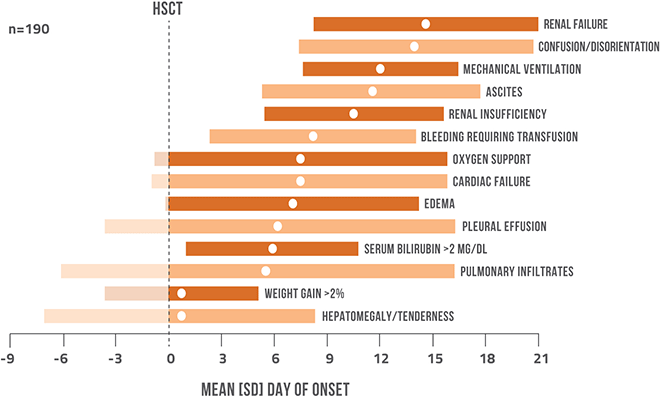Signs of Progression
Be alert for signs of renal or pulmonary dysfunctionBe prepared to act on VOD/SOS
Signs and symptoms of multi-organ dysfunction may be predictive of VOD/SOS progression and poor survival1,2
Early onset1-3
Signs and symptoms such as weight gain, hepatomegaly, and elevated bilirubin may appear early and worsen quickly post HSCT
Rapid worsening2
Short time from the first clinical symptoms to the date of VOD/SOS diagnosis
High magnitude of severity1,2,4
Symptoms of severe liver dysfunction and extreme elevation in liver lab values
Approximately 30% to 50% of cases developed multi-organ dysfunction5,a
Renal dysfunction may include3,6,7
- Decreased urinary output
- Elevated creatinine levels (≥1.5 x baseline)
- Decreased creatinine clearance
- Decreased glomerular filtration rate
- Need for dialysis
Pulmonary dysfunction may include1,3,7,8
- Pulmonary infiltrates
- Pleural effusion
- Reduced oxygen saturation
- Need for supplemental oxygen (nasal cannula)
- Ventilator dependence
As VOD/SOS progresses to hepatorenal dysfunction, reversal of portal venous outflow may occur; this change in portal circulation is a late-stage finding of VOD/SOS9,10,11
84% overall mortality in VOD/SOS with multi-organ dysfunction12,b
- Based on a study conducted by Carreras et al that used 2 sets of diagnostic criteria to estimate the incidence of VOD/SOS after HSCT.5
- Based on 19 studies (235 patients) that specifically determined mortality from severe VOD/SOS, as reported within a meta-analysis of 135 studies performed between 1979 and 2007.12
VOD/SOS can rapidly progress to renal or pulmonary dysfunction1,2,13
Average time of onset of symptoms in VOD/SOS post HSCT2

Study design: Time of onset of VOD/SOS and multi-organ failure is based on 190 patients from a prospective cohort evaluation of 355 consecutive patients. A diagnosis of VOD/SOS was made based on the occurrence of 2 of the following events within 20 days of transplantation: bilirubin >2 mg/dL, hepatomegaly or right upper quadrant pain of hepatic origin, and sudden weight gain (>2% of baseline weight). No other explanation for these signs and symptoms could be present at the time of diagnosis.1,2